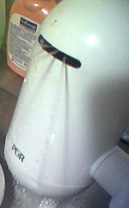Published Aug 30, 2004
I’ve recently had the privelege of interacting with two vendors who had sold their goods to me: Dell and PUR, the water filter people. It’s amazing how differently I was treated by the two — and amazing how the big-ticket purchase got me the worse service.
Dell was, as you’ve probably already guessed, the bad service. I bought two items from them: a $2,000 laptop and an $80 wireless router. As already related, the router was not the finest-made product I had ever procured. Unfortunately, the replacement they sent could be made to work either. I suggested to Dell that I simply return the item — if neither instance worked, then why should I expect that the product worked at all? — but they preferred to send me a third router and were quite vociferous that the cause was something in my environment, even though my old AirPort Base Station worked fine. Of course, all of this happened on their schedule, and I was happy to be flexible during my vacation, but the third router arrived the weekend before school started. Naturally I was uninterested in spending my time setting up the new router at the same time that I was getting used to classes, etc.
But Dell was adamant: no non-function of the router provided cause for me to return the item for a refund. I’ll admit; I was annoyed. Even worse, I began to doubt Dell. My mental image of my purchase switched from roughly 95% laptop and 5% router to 1 of 2 items working and 1 of 2 items non-working. And what would Dell gain? My $80? In fact, they lost, because now I think of them as the company that sells crappy peripherals and sticks you with them when they don’t work. And, if I buy a PC in the future, I’d seriously consider an HP — when I shopped for this laptop, Dell and IBM (muy caro!) were the only vendors I looked into.
In contrast, I couldn’t be happier with the customer servide PUR provided me for my $30 on-faucet water filter. The filter housing has a little plastic window that lets you see a progress bar on that tells you when the filter is used up. This plastic window broke seal on my unit, so, every time you run water through the filter some shoots out in high-pressure streams:

I’d only owned this filter for about 9 months and was sad to see it break already. So I asked them on their site, is there any way I can repair this? Their reply:
Thank you for contacting PUR.
I am sorry to hear of the problem you had with our product. The quality of our products - their content, performance and packaging - is very important to us. We have many quality control checkpoints along the manufacturing line because we want each of our brands to be in perfect condition when purchased by our consumers. I’m sharing your comments with the rest of our team. Since the amount of help I can offer via email is limited, I’m following up with you by postal mail. I will be sending you a voucher for a new unit. Please allow 3-4 weeks for delivery. Thanks for getting in touch with us.
That was the very first e-mail they sent back! They quickly turned a customer who feared he burnt $30 into a customer who trusts his vendor for future transactions. What could be a better outcome?
Here we have two really different outcomes of similar situations. Both dealt with commoditized products (I will assert that all PC laptops are good substitutes for each other, so we’re most of the way down the commoditization path, despite the price). Both dealt with manufacturers who need to fight for “mindshare”, who will either be the first vendor you think of when you need a new widget or will not get a shot at the sale. One was proactive and managed the interaction to get what I might consider a good result and was, at least, not a costly result for them. The other was responsive but stayed behind the curve and put themselves in a position in which the failure of their initial response (a reasonably predictable failure) would only leave me less satisfied. There’s a lesson here about how, as James Carville would have said, speed kills. Customer service needs to respond quickly and aggressively to resolve issues on the first or second contact. That’s the only way to keep customers in today’s competitive, information-filled marketplace
